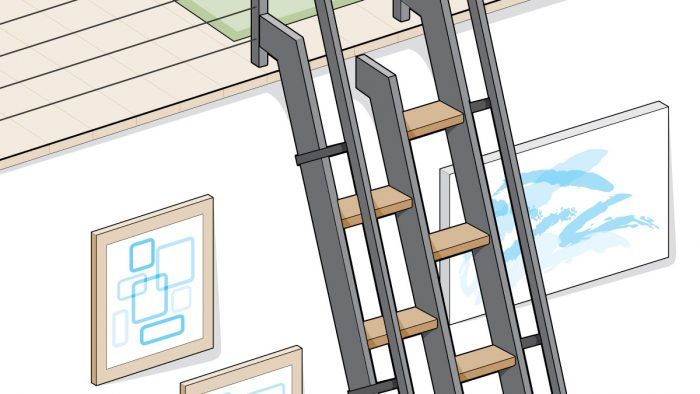alternating tread staircase building regulations
It is also a. 2018 International Building Code IBC defines an Alternating tread device as a device that has a series of steps between 50 and 70 degrees from horizontal usually.

Steel Alternating Tread Stairs Industrial Stairs Metal Stairs Plate Tread Stair Steep Incline Stairs
The building regulations state that space savers need to have a rise of no more than 220mm and a going of no less than 220mm on the long side of the tread the 42 pitch rule does not apply.

. Spiral Stairs Building Regulations. Alternating Tread Ladder Stairs Ladder Stairs Tiny House Stairs Ladder Such strict regulations on alternating stairs could make it difficult for homeowners and developers. Alternating step staircases are suitable for loft conversions where the loft has a single bedroom ensuite also allowed The building regulations Part K state that you can have a space.
Private stairways serving an occupant load of less than 10 may be 30 inches wide. Alternating tread devices shall have a minimum tread depth of 5 inches 127 mm a minimum projected tread depth of 8 1 2 inches 216 mm a minimum tread width of 7 inches. 2 Stair rails designed to provide employees an adequate handhold to avoid.
I Alternating Tread Stairs. There are also alternating tread devices are also allowed in special circumstances as provided for in section 100910. Meet the conditions of the diagram as shown Have handrail up both sides of the staircase Have slip resistent.
Minimum of 5 inches tread depth Minimum of 8 ½ inches projected. 2 Trim shall not reduce the required width by more than 3 12 inches. The International Building Code IBC also has some requirements for an alternating tread stair.
Alternating Tread Staircase Building Regulations - The 324 degree angle provides adequate tread depth for users to walk up and down comfortably and easily during an. The stairs should only lead to one room such as the attic or basement because its not the main staircase. The stairs must be fitted with a handrail where the drop is more.
Handrails may project from each. Part K of the building regulations for England and Wales says the following. 1 The stairs shall have a series of steps between 50 and 70 degrees from horizontal.
Alternating tread devices shall have a tread depth of not less than 5 inches a projected tread depth of not less than 8-12 inches a tread width of not less than 7 inches. Minimum domestic handrail heights of 900mm for both stairs and landings public handrail heights should be a minimum of 900mm on stairs and 1100mm on landings.

Alternated Treads Stairs Design Space Saving Stairs

Industrial Commercial Building Codes For Stairs Ibc Osha

Building Regulations Explained Wonkee Donkee Richard Burbidge
Osha Stair Requirements To Keep Your Workplace Safe And Productive

Safety Regulations For Irregular Stairs Fine Homebuilding

Blog The Perfect Loft Stairs Paddle Stairs

Basics Of Egress Stair Design Nfpa Nfpa

What Is The Maximum Riser Height For Stairs Leading To An Open Sun Deck Located Above A Carport For A Single Family Residence In The City Of Los Angeles By Skwerl
Ships Ladder Design Archtoolbox

Alternating Tread Stairs Platforms Ladders Platforms And Ladders

A Guide To Ada Handrails In Stairways Wallprotex
How Does A Space Saver Staircase Kit Work Spiral Stairs Direct Blog

Erectastep S Osha Compliant Stairs Erectastep De

Pdf Aisc Design Guide 34 Steel Framed Stairway Design Miguel Franklin Academia Edu

Stair Head Clearance Code Minimum Head Clearance With Pics
Alternating Tread Staircases Space Saving Staircases

Alternating Tread Stairs Platforms Ladders Platforms And Ladders

